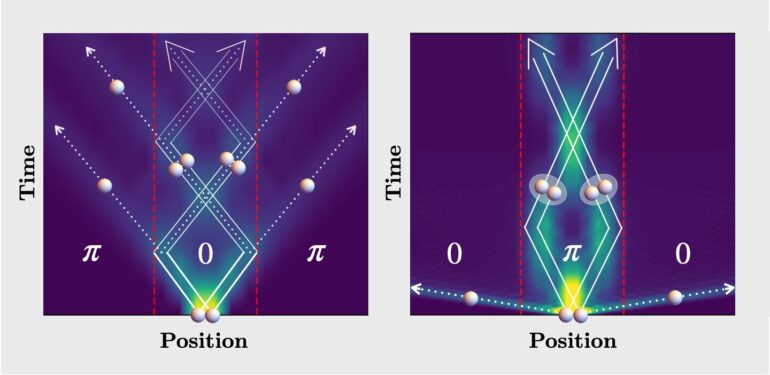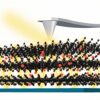In the world of fundamental particles, you are either a fermion or a boson but a new study from the University of Cambridge shows, for the first time, that one can behave as the other as they move from one place to another.
Researchers from the Cavendish Laboratory have modeled a quantum walk of identical particles that can change their fundamental character by simply hopping across a domain wall in a one-dimensional lattice.
Their findings, published as a Letter in Physical Review Research, open up a window to engineer and control new kinds of collective motion in the quantum world.
All known fundamental particles fall in two groups: either a fermion (“matter particle”) or a boson (“force carrier”), depending on how their state is affected when two particles are exchanged. This “exchange statistics” strongly affects their behavior, with fermions (electrons) giving rise to the periodic table of elements and bosons (photons) leading to electromagnetic radiation, energy and light.
In this new study, the theoretical physicists show that, by applying an effective magnetic field that varies in space and with the particle density, it is possible to coax the same particles to behave as bosons in one region and (pseudo)fermions in another. The boundaries separating these regions are invisible to every single particle and, yet, dramatically alters their collective motion, leading to striking phenomena such as particles getting trapped or fragmenting into many wave packets.
“Everything that we see around us is made up of either bosons or fermions. These two groups behave and move completely differently: bosons try to bunch together whereas fermions try to stay separate,” explained first author Liam L.H. Lau, who carried out this research during his undergraduate studies at the Cavendish Laboratory and is now a graduate student at Rutgers University.
“The question we asked was what if the particles could change their character as they moved around on a one-dimensional lattice, our notion of space.”
This research is partly motivated by the remarkable prospects of being able to control the nature of particles in the laboratory. In particular, certain two-dimensional materials have been found to host particle-like excitations that are in between bosons and fermions—called “anyons”—which could be used to build robust quantum computers. However, in all setups so far, the nature of the particles is fixed and cannot be changed in space or time.
By analyzing mathematical models, the present study shows how one can juxtapose bosonic, fermionic, and even “anyonic” spatial domains in the same physical system, and explores how two particles can move in surprising ways through these different regions.
“The boundaries separating these regions are very special, because they are transparent to single particles and, yet, control the final distribution by how they reflect or transmit two particles arriving together!” said Lau. The researchers illustrate this “many-body” effect by studying different arrangements of the spatial domains, which give rise to strikingly different collective motion of the two particles.
“These variable two-particle interferences are fascinating in their own rights, but the new questions they open up for many particles are even more exciting,” said Dr. Shovan Dutta, the study’s co-author who conceived and supervised the research in the Cavendish and has recently moved to the Max Planck Institute for the Physics of Complex Systems.
“Our work builds on recent progress in engineering artificial magnetic fields for neutral atoms, and the predictions can be tested experimentally in existing optical-lattice setups,” added Dutta. “This will open access to a rich class of controllable many-particle dynamics and, potentially, technological applications, including in quantum sensing.”
More information:
Liam L.H. Lau et al, Quantum walk of two anyons across a statistical boundary, Physical Review Research (2022). DOI: 10.1103/PhysRevResearch.4.L012007
Provided by
University of Cambridge
Citation:
Mutating quantum particles set in motion (2022, February 8)



